INTRO:
It is not often that a game would present survival- and exploration-oriented gameplay like a board game of sorts. NEO Scavenger is one such title.
Furthermore, for a genre which has been around for a while, survival games have been mainly real-time affairs. NEO Scavenger does not break its mould by being turn-based, but there are not many survival games out there which rely on turn-taking.
NEO Scavenger makes use of the eponymous gameplay of scavenging to implement a sense of urgency. Unfortunately, this critical part of the gameplay is very luck-dependent, making a successful playthrough to be as much a result of good luck as good skill, if not even more.
PREMISE:
The player character is a certain amnesiac that wakes up in a cryogenic storage facility. Shortly after that, he/she is confronted with a threat, which in turn reveals that humans have to share their world with ravenous monsters. Next, after exiting the facility, the player character learns that everything seems rather dismal and run-down, with little signs of civilization in the vicinity of the facility.
The premise is not completely post-apocalyptic of course. After a certain milestone in the progress of a playthrough, the player would learn that the game takes place in a somewhat partially sci-fi dystopian future, specifically in what used to be the state of Michigan in the USA.
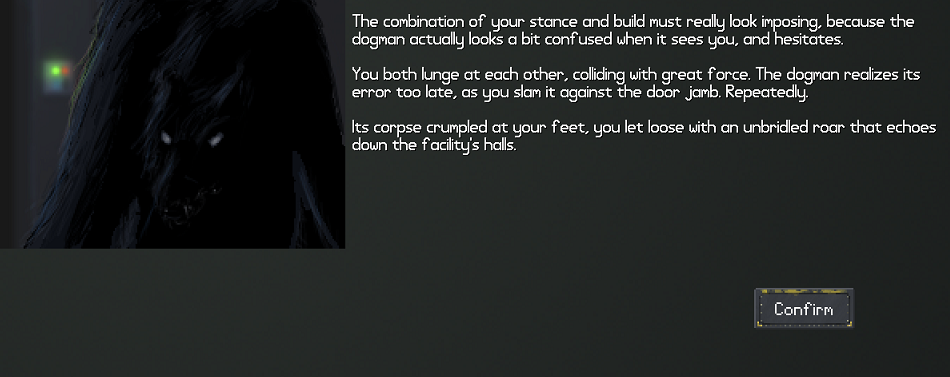
Unfortunately, the game is only “feature-complete”, to use that typical term that professionally trained game developers often use. Narrative-wise, there has yet to be anything substantial that explains why the city of “New Detroit” is like a tribute to Blade Runner and how the regions outside of the city is more like the “Zones” in the Roadside Picnic novel (despite a newspaper snippet that suggests that there has been an agricultural calamity).
Every update brought with it something more, but as of the latest build of the game which implemented the end-game, any further story-telling would be reserved for a sequel in the state of Indiana.
SELECTING “SKILLS” & “TRAITS”:
As of this time of writing, the player character is a certain adult male, likely bald. However, the other characteristics of the protagonist, namely his capabilities and physical flaws, are up to the player to decide.
“Skills” are the positive physical qualities which the protagonist has. The player has a limited pool of points which he/she can spend on taking on some, but not all, of these qualities.
There is generally no way to gain the other qualities which the player did not pick, later in the playthrough. There are cybernetic enhancements which do grant some “skills”, but these are late-game benefits, there are few of them and the developer does not appear to be keen about introducing many of such enhancements.
Therefore, the player will have to pick the protagonist’s skills carefully. Most of them do have some use during a playthrough, but the benefits of some will not be enjoyed until much later, if the player character survives long enough to accrue the resources necessary to do so.
The player can also choose to pick so-called “Traits”. Most of these are bad for the player character, such as Myopia, which reduces the player character’s sight range and make him less capable of spotting hidden things. “Metabolism” is the only trait with an up-side; in addition to the penalty of getting hungrier and thirstier faster, it also grants improved natural healing.
The incentive for taking traits is that they give more points for the player to spend on skills. However, there are some traits and skills which are mutually exclusive. For example, Myopia obviously cannot be taken together with Eagle Eye.
Players who do research on the content of the game beforehand (and thus spoiling a lot of things for themselves) would have an advantage in knowing which traits and skills to pick.
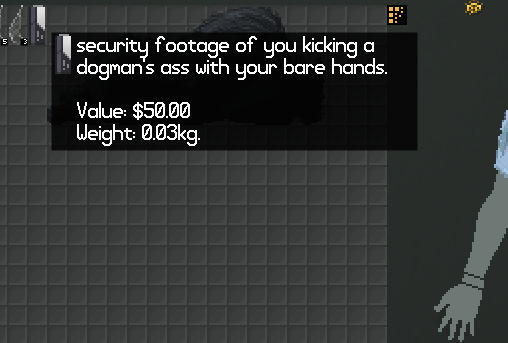
GRID-LIKE, DRAG & DROP MENU SYSTEM FOR DECISION-MAKING:
One part of NEO Scavenger particularly stands out: its user interface requires the player to drag and drop icons onto a grid when making a decision during a scenario. One side of the screen is occupied by a grid which has icons which the player can drag and drop onto another grid on the other side of the screen; the latter is called the “combo grid” for convenience.
This is supposed to be used for a system of combos of sorts. One example can be seen early in the game: the player can choose a skill (or two) by dragging and dropping its icon onto the combo grid, followed by the icon of an object in the immediate environment in order to have the player character interact with the object through the use of that skill.
In practice though, such a user interface design is only there to accommodate icons of different sizes. To elaborate, the player can place icons into the combo grid on the right of the screen in any order; the location of an icon relative to the other icons also will not matter either. To describe it simply, the combo grid is little more than a bin into which the player chuck things into.
In fact, such a UI design might even seem cluttered. The icons for items, skills and even special opportunities are all stuffed into the same grid on the left. There are buttons to rearrange the icons so that they seem orderly, but there are not any filters which could be used to only show what the player wants to be shown.
There may be a lost opportunity here to make the system more sophisticated than it is. Perhaps the order of the placement of icons into the combo grid could have mattered, for example, if the player character is to handle a situation in a certain order of actions.
INVENTORY GRIDS:
Fortunately, the grids are also used for a more familiar application: the storage of items and management of inventory. Every physical item is represented by an icon which occupies a square or rectangular area of cells, so players with pack-rat tendencies should find such a system to be simple.
Unfortunately, the icons do not come with outlines which show how much space they occupy. Some items, especially guns, would look like they occupy areas which are not rectangles, but they do. Rotating their icons helps alleviate this tediousness, but only a little.
Interestingly, the number and extent of the inventory grids which the player character has are determined by the gear which he is using. For example, if the player character is wearing clothes with pockets or pouches, small grids would appear next to the representation of his body in the user interface; these small grids allow the player to store small objects which could ostensibly go into pockets.
There are a considerable number of things which provide inventory grids. These things happen to be gear which go into the gear slots that represent whatever the player character has equipped.
GEAR SLOTS:
For an individual who starts out wearing nothing more than a hospital gown and a curious talisman (more on this later), the player character could go on to wear or strap on a considerable number of items.
Firstly, there are the clothes which he can wear: pants, shoes, something over his torso and gloves. The hospital gown also counts as a shirt of sorts, and it so happens that the player character can wear up to three shirts. On top of these, he can wear a vest, and on top of the vest, an overcoat.
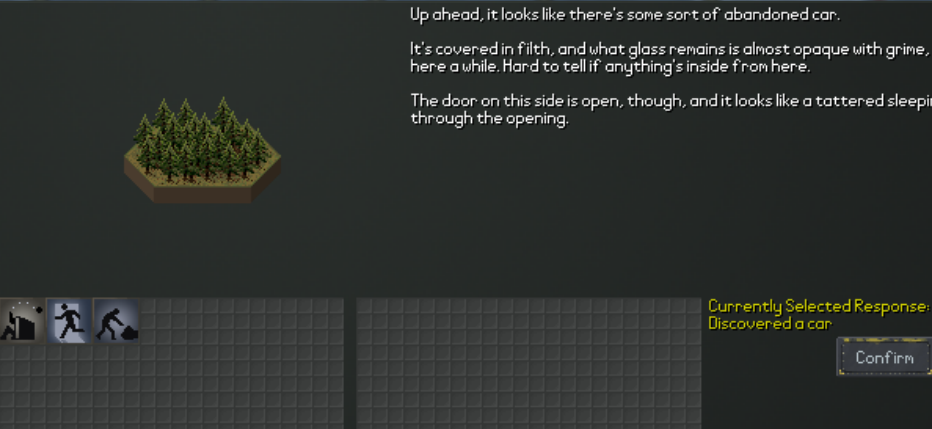
Curiously though, there are no hats. There is gear which can be worn over the eyes, face or mouth, however. Also, according to the developer, as written on his development blog, the head slot was somehow a tad more difficult to implement than expected.
His two shoulders and armpits also act as inventory slots, though these will not be immediately clear to the player until the player comes across an item with a strap. Curiously, the right shoulder can only be used for strapped weapons, while the other shoulder is for sling bags.
Then, there is the neck slot, which can allow for up to three items (with straps) to be equipped in it. Without having done research, e.g. looking this up in wikis for the game, it is unlikely that the player would even know that multiple items can go into this slot.
A GAMUT OF IMPORTANT CONDITIONS:
Present-day survival games usually implement elements which introduce a sense of urgency and desperation in the gameplay experience. Typically, this is the video-game equivalent of hunger, sleep and temperature.
NEO Scavenger has these conditions for the player to worry about, and even more. In fact, just about each and every one of them can lead to the death of the player character if the player does not keep an eye on them.
The conditions are labelled with text descriptions which change as their measured quantities change. For example, when the player character’s Hunger meter is full, its text description is “Sated”.
Yet, there are some conditions which have labels that do not immediately explain their significance. For example, there is a meter which when full, has the label “Comfortable”. After the meter drops to the orange level, its text label – “Shivering” at this level – would reveal that it is associated with the player character’s body temperature.
The unique effects of each of the conditions will be described later in their own sections. However, generally, if any of them deteriorates to a critical state and then gets worse, the player character simply dies and it is game-over.
Furthermore, some conditions might be hidden from the player, due to certain design decisions on the part of the game’s developer.
THIRST & WATER:
Of all the things which the player character will have to consume more regularly than other things, it is water. Fortunately, the (almost) post-apocalyptic world which the game is set in is not an arid one; there is quite a lot of water to be had, if the green grass under the protagonist’s feet does not suggest so already.
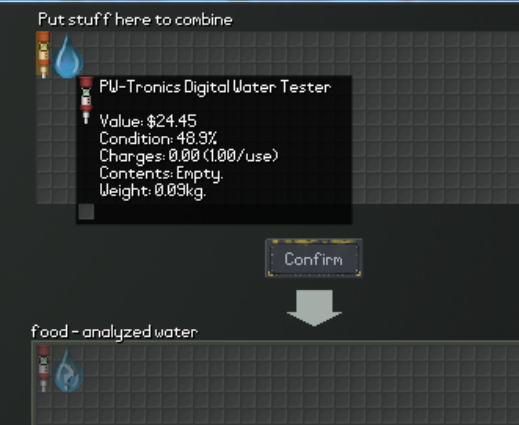
However, not every bit of water that is to be found is potable, and the player would not know this immediately. Drinking water that turns out to be infected is an easy way to become sick, and it will take a long while to recover from waterborne diseases, if at all.
Interestingly, water can exist in the game on its own, without any container. However, without any container, water can only be found in the grid for items on the ground. There are many containers, fortunately, and each can carry at least two units of water.
Boiled water is guaranteed to be sterilized. Water can only be boiled if it is in a container, but not every container allows boiling. For example, glass bottles do allow boiling, but they are immediately destroyed afterwards, so the player will need another container to hold the boiled water. Plastic bottles obviously cannot be used for boiling water at all.
Interestingly, items which are included in the game mainly for the purpose of holding water has no durability rating whatsoever, meaning that they will not degrade over time.
Water is also used for boiling rags in order to clean them, but if the player is forced to use clean rags for one of their very few uses, his/her playthrough is likely doomed to failure anyway. There will be more elaboration on this later, when treating wounds are described.
Dehydration is particularly debilitating, more so than any other critical conditions. Dehydration will hobble the player character’s mobility, the probability of success at crafting and the regulation of body temperature. If it is not obvious to a (very stupid) player that keeping hydrated is important, the game will impart a harsh lesson soon enough.
HUNGER & EATING FOOD:
The player character will need to eat to survive. Having the player character well-fed is also essential for naturally healing the player character’s injuries and replenishing his blood supply (more on these later). Starvation is almost as bad as dehydration, though the onset of starvation can take a lot longer to happen than dehydration.
The player character can eat many things, but not everything is edible. For example, blueberries are described in-game as guaranteed to be edible, but every other kind of berries can be either poisonous or edible. If the player character does not have the Botany skill, the player won’t be able to know this. Colour association will not help either, because berries of the same colour can have both poisonous and edible variants.
Almost all edible food items will eventually degrade. In the case of edible berries and mushrooms, they simply disappear from the player’s inventory once their condition reaches 0%. In the case of meats, they spoil, obviously becoming toxic.
Interestingly, junk food such as candies and potato chips last forever. This makes them useful for emergencies, if the player is wise enough to keep some of them around.
That said, a player character with the Botany skill might have an advantage in keeping fed. With it, he is able to forage for berries rather easily, because there are a considerable number of forests and pastures around for this purpose.
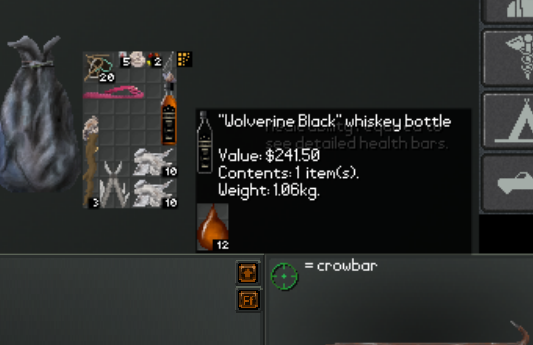
SLEEP:
The player character is seemingly more energetic than a regular human being, considering his ability to stay awake for what seems to be more than a day. However, he will eventually need to sleep. Unlike other critical conditions, a severe lack of sleep is not immediately fatal.
On the other hand, the player character will collapse, and will be out far longer than if he had been regularly sleeping. Going to sleep in such a manner is also very inefficient, since the amount of rest obtained this way is rather little compared to the time that he is out. Most importantly, the player character will be vulnerable to attacks in this state; just about any other character who happens upon the unconscious player character can choose to just end his life right there.
Sleeping regularly is not without its risks either. Any enemy which has been tracking the player character (more on tracking later) will likely make an attempt on his life when he sleeps, especially if he is too powerful to take on in a fight.
The player character can be woken up during a sleeping stint, though this is mainly an RNG roll. There are factors which affect the roll (or the threshold which the roll must pass), such as ambient noise, the weather and any attempts by enemies to sneakily approach the player character. There is also an item called the “noise trap” which improves the chances of being woken up to a murder attempt by sneaky enemies.
However, ultimately, being woken up to such occurrences is a matter of luck. Despite the player’s precautions, the player character could still have his throat cut (or torn out, in the case of monsters) or his head smashed in during his sleep.
There is also the quality of sleeping too; this is represented by the ‘Sleeping’ meter when the player brings up the “Shelter” screen for a tile. Higher ratings lead to better sleep, meaning that the player character has more time to stay awake before having to sleep again.
As the player character sleeps, the player character’s other statistics will change too. For example, he will still become thirstier and hungrier as he sleeps. The degradation rate of these statistics when he sleeps is in turn dependent on the “Shelter” rating of the tile which he is on. This rating is determined by the locale on the tile which the player has chosen for the player character to camp in. For example, intact buildings provide the best shelter ratings. The rating can also be improved by setting up a tarp shelter and placing it in the camp grid.
PAIN:
The player character is ultimately mortal, so pain will be an issue if he ever gets hurt. There are many dangers which do inflict injury in this game’s version of Michigan though, so not getting him hurt is easier said than done.
Anyway, in addition to dealing with the other consequences of injuries, there is the pain from them. If the player character suffers too much pain, he might fall unconscious, leading to the same problem as suffering lack of sleep. If there is just too much pain, beyond even fainting once in a while, he simply dies from shock.
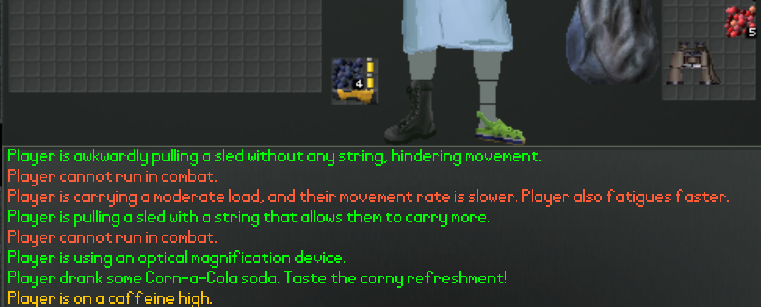
Severe pain will hamper the player character’s abilities. The only way to actively manage pain is to consume painkillers regularly, at least until the cause of the pain goes away.
METERS AVAILABLE TO SPECIFIC SKILLS ONLY:
There are certain conditions with meters which are visible to the player if the player character has specific skills; otherwise they are hidden from the player. For example, player characters with the Medic skill will be able to see the Blood meter, which shows how much blood that the player character has left in his body after taking wounds.
This limitation can seem problematic to players who would prefer to be informed about gameplay-critical matters without any restrictions. Returning to the example of the Medic skill and the blood meter, if the player character does not have the skill, the player will have to gauge, through experience alone, how much blood he has left before symptoms of severe blood loss appear.
It is worth pointing out here that the “Tough” skill can complicate the estimations of conditions which do not appear in the user interface. This skill makes the player character rather resilient to any deterioration of factors which affect his health. Although this sounds good, it also means that when symptoms do appear, it would be too late to save him.
OTHER STATISTICS WITH METERS:
There are other statistics which are important, but they do not appear as often as the aforementioned ones. For example, there is “Sweating”, which only comes up if the player character is in hot places (and there are scant few of such places) or if the player character has ingested some caffeinated drinks. Sweating causes the player character to become thirstier faster; higher ratings mean faster loss of water. However, Sweating is a condition which goes away very quickly.
BUFFS & DE-BUFFS:
Some other conditions apply their effects in a binary manner, i.e. either the player character has them or not. There are no meters which gauge their severity. In other words, these conditions act much like video-game buffs and de-buffs. For simplicity’s sake, these conditions will be referred to as such.
More often than not, these de-buffs and buffs (the former are more numerous than the latter) are caused by items which are worn or consumed by the player character. For example, wearing mismatching shoes will cause the player character to develop painful blisters, which will reduce his number of moves per turn.
Some of these de-buffs and buffs are only temporary. Returning to the example of painful blisters caused by improper footwear, they will eventually go away, even if the player character keeps wearing said footwear; the player can assume that the footwear has been “broken” in. However, the footwear item itself will not register any changes, e.g. of the two left shoes which the player character wears, one of them will not turn into a right shoe regardless of how long it is worn.
This also means that de-buffs can be re-applied if the player removes and re-equips the offending item. Returning to the example of improper footwear, the player could unwittingly re-apply the de-buff of painful blisters if he/she, for whatever reason, removes one of the left shoes and re-wears it. Furthermore, there is a glitch that can cause the de-buff to stack.
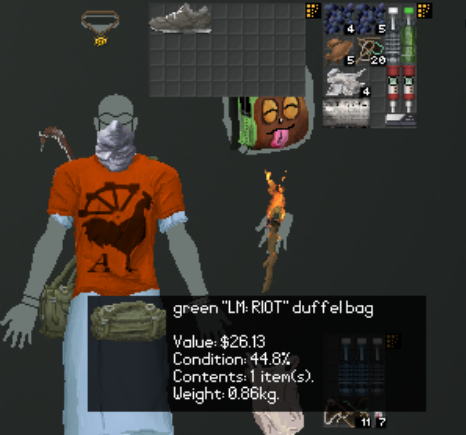
BLEEDING & TREATING WOUNDS:
Bleeding is a particularly notable de-buff, because it is associated with injuries of the laceration kind.
Bruises are injuries, but they generally do not cause severe bleeding unless they become a lot worse. Cuts, however, always cause bleeding and will do so until they are treated.
Minor injuries, such as small bruises, can be left alone; they will eventually heal on their own. However, more serious ones must be treated, lest they become infected, thus inflicting more ailments on the player character. The methods of treatment might be apparent to people who are versed in first-aid: clean the wound with water or alcohol, and then bandage it with clean fabric.
Doing just the latter can slow and eventually halt the bleeding, but without cleaning the wound, there is a considerable chance of infection. Cleaning with water is the minimum, but there is still a small chance of infection. Cleaning with alcohol guarantees no infection in the short term, but it causes pain.
Rags are the only usable fabric for bandaging. They will degrade over time, faster if the cuts which they are bandaged around are particularly nasty. Dirty rags are very likely to cause infection, so the player will want to regularly check the condition of bandages and replace them before they turn bad.
There may be a problem with checking the wounds under the bandages though: the player cannot check the condition of the wound without removing the bandage, which will obscure the wound. Unfortunately, this restarts bleeding again, and doing this too much will eventually cause the player character to lose too much blood. Therefore, to be efficient at healing, the player should only check the wound when replacing bandages after they have deteriorated too much. (This will restart bleeding anyway, if the cut has yet to improve to a level that does not cause bleeding).
With these complexities in mind, it is usually in the player’s interest to consider avoiding risk of injury in the first place, though this is, much like any other challenges in the game, easier said than done.
MOVES & TURNS:
The number that the player would perhaps pay the most attention to are the move points which the player character has left before having to end his ‘turn’.
This number defaults at a maximum of 5.00; it rarely, if not never, goes any higher. Its maximum can be lowered though, usually due to de-buffs such as the aforementioned painful blisters. In fact, the player character can be hobbled so severely to the point of having hardly any movement points at all.
Generally, moving from the tile which the player character is on to another tile costs 1.00 points. There may be tiles which cost more points to be moved onto, such as tiles with ruined buildings.
Move points are also used for crafting, which will be described later. However, consuming items, such as eating food, generally does not use any move points.
Obviously, after the player character has spent all of his available move points, he can no longer do anything and has to end his “turn”. The other characters which are active in the game world will then take theirs. There will be more elaboration on who or what the other characters are and what they can do later.
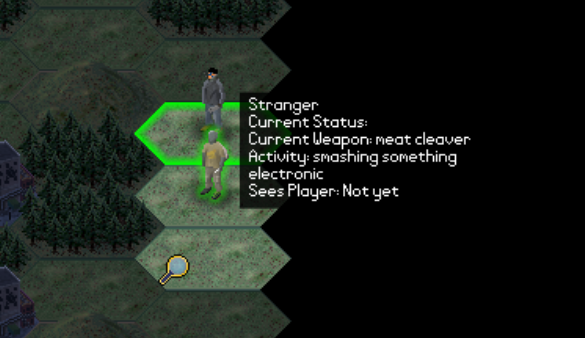
WORLD, FOG-OF-WAR & TILES:
Michigan is a grid of hexagon-shaped tiles. Like just about every other game with procedural generation of its game world, the Michigan of one playthrough will be different from the Michigan of another.
However, the key difference about NEO Scavenger’s procedural generation is that it is not done prior to the start of a playthrough. Instead, it occurs as the player character discovers new tiles, typically through his sight. This acts as a counter against mods which reveal the game world.
On the other hand, this also means that a playthrough’s save-file will grow in size as the playthrough progresses. Nonetheless, the save-file is not very large, even after the player has explored and uncovered much of Michigan.
In addition to uncovering whatever terrain or structure there is on a tile, the player will also uncover characters, for better or worse (usually the latter). The nature of these characters strongly depends on where in Michigan they are. For example, the worst of Michigan’s denizens usually spawn up north; incidentally, the player character almost always starts the playthrough at the southwestern part of the world map, which does not have dangers or risks as severe as elsewhere, at least not initially.
SIGHT RANGE:
As mentioned already, tiles in the game world will only be uncovered if the player character is able to see them. By default, at the brightest possible time of the day and good weather, the player character can see up to three tiles away. However, these are ideal conditions, and in a game where the weather is controlled by fickle RNGs, these do not occur consistently.
Cloudy and rainy weather will reduce the player character’s sight range, as well as those of other characters. It also makes the detection of hidden characters more difficult.
There are skills which improve the player character’s sight range, such as Eagle Eye. Standing on high ground, such as hills, also happen to increase his sight range too.
There are also items such as binoculars which increase his sight range, though these either have to be held in his hands or strung around his neck in order to be (somehow) useful. (Speaking of binoculars, a player character with the Mechanic skill can break these down into halves, which together are curiously more valuable than full binoculars.)
The line of sight of a character can be broken by obstacles such as forests, buildings and hills. These terrain types are as common as those that do not block line of sight, e.g. clear plains and meadows. The player might want to be careful when moving through sight-blocking terrain; there could be an unpleasant surprise on the other side of them.
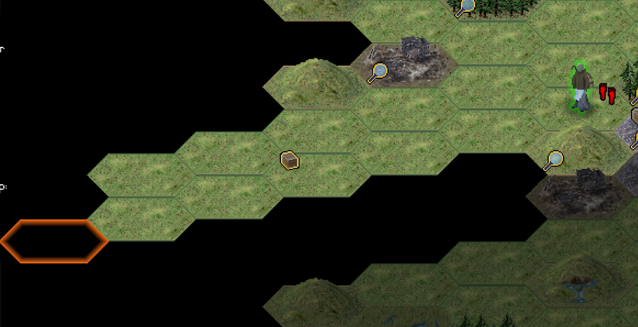
TERRAIN TYPES:
Tiles can be categorized according to their terrain types. Plains and barrens are the most uninteresting, as well as the least fruitful when subjected to foraging. Meadows are slightly better than plains at yielding food items, though the tiles which are best at yielding food items are green forest tiles.
However, green forest tiles are also where characters can hide. Even if they are not actively trying to hide, the forest tile can obscure them anyway. This can result in potentially unpleasant bumps into strangers, animals or worse.
Most terrain types are not actively hazardous to the player character. However, there are a few types which are, such as the poisonous swamps to the south of Michigan. These terrain types can afflict the player character with diseases if he spends too much time in them.
SCAVENGING, FORAGING, SCROUNGING & LUCK:
The most important gameplay element is the eponymous act of scavenging. Almost every tile has one or more locations which can be searched for stuff.
The types of stuff to be found are highly dependent on the location. For example, storage sheds usually yield the most useful stuff, crumbling buildings almost always yield rocks and glass shards, and forests always yield plant-based items.
There are also probabilities for three occurrences: the probability of actually finding something (“Loot”), the probability of not getting injured while scavenging (“Safety”) and the probability of scavenging without alerting other nearby characters (“Sneak”).
Ostensibly, the player could prioritize certain tiles to spend move points on scavenging activities. In addition, the player could attempt to min-max the probabilities by applying the right mix of skills and tools for the scavenging attempt. For example, the player could use a flashlight instead of a lighter, so that the latter could be used for lighting fires instead (more on fires later).
Interestingly, the tools and skills which can be applied for the purpose of scavenging are categorized according to the permutation of benefits and penalties which they provide. For example, torches, lighters and flashlights (and electronic devices which are equipped with lamp software) are placed under the same category, because they improve the “Loot” factor while reducing “Sneak”. Only one item or one skill from each category can be applied to the act of scavenging.
Unfortunately, scavenging is an activity that is much, much more dependent on luck than familiarity and experience on the part of the player.
This is because the three aforementioned probabilities only determine whether the player character has been successful at obtaining anything without alerting anyone else to his presence and without getting injured. They do not seem to affect what the player character would actually get upon success.
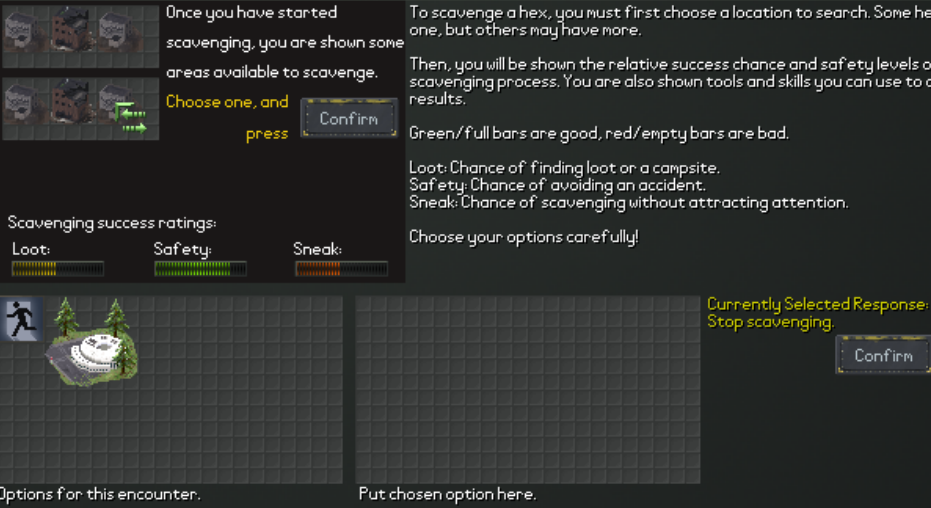
For example, the player could invest a lot of skills and items into a scavenging attempt on a storage shed, in the hope of finding a particularly useful item such as a crowbar (which is an incredibly handy tool that can be used for combat, prying open locks, and even cooking meat over a fire). Unfortunately, the player might just get something else that is much less useful, such as plastic bags when the player character already has superior container items.
Considering the fact that the player character only starts out with a hospital gown, the player could run into really bad luck, failing to find the items which are necessary to prevent the player character from dying from exposure. It is rare indeed that this can happen, but it can.
This reviewer personally had a playthrough where the player character only found a shirt after half an hour since the beginning. There is also another playthrough where a pair of left and right shoes (regardless of shoe model) are only found two hours later.
Of course, there can be the argument that the player could attempt to compensate for not getting specific items by picking specific skills to make do without these items. For example, there is a skill which allows the player character to start fires without resorting to a lighter. However, this means that the player would be forgoing other skills, which can be just as important to the player character’s survival.
It is worth noting here that a tile which has been cleaned out will not stay cleaned out. Its scavenging opportunities will eventually be replenished, though this only occurs after a long time.
SCARCITY OF SCAVENGING OPPORTUNITIES IN VICINITY OF NEW DETROIT:
The player will be alerted very early on in a playthrough about the presence of the city of New Detroit. Indeed, in order to make any narrative-related progress in a playthrough, the player will have to reach the city. However, the game will inform the player that scavenging activities will yield less and less items as the player character gets closer to the city. This is an understandable limitation, as the game would explain.
“USING” SPECIAL ITEMS ENDEMIC TO CERTAIN TILE TYPES:
Certain tile types are characterized by special “items” which appear in the “items on the ground” grid. These “items” cannot be taken away in any way, because they are part of the terrain on the tiles. For example, forest tiles always have items which represent the trees on the tile.
The player can “use” these special items in order to obtain guaranteed yields of specific items. Returning to the example of the forest tile, “using” the trees yield branches both large and small, as well twigs. Such yields will always occur, even if the player is close to the city of New Detroit.
Speaking of the city, another example is the illegal power taps in certain tiles in the shanty areas of New Detroit. These will always yield electrical charges, which although not portable on their own, can be shifted in and out of any battery-type item.
To prevent the player from exploiting these designs, most of the items which are yielded by such special tile-specific objects often have no selling price whatsoever. However, there is still at least one exploit, which will be described shortly.
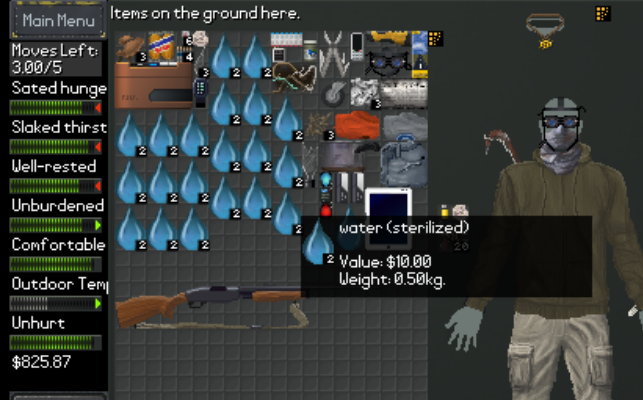
WATER-HARVESTING EXPLOIT:
Observant players might notice that sterilized water carries a considerable price in the Junk Market of New Detroit. Afterwards, they might formulate a plan which involves trips to a water source that is the closest to New Detroit, and either bringing back water in containers so that it can be boiled at the (inexhaustible) communal fires in the shanties, or bringing back clean water after testing harvested water with water analysers (which are later recharged with the illegal power taps).
The developer either does not seem to be informed about this exploit or has not seen fit to close it. The exploit could have been solved by attaching restrictions or risks on the use of the illegal power taps or the communal fires.
NEW DETROIT:
The city of New Detroit has been mentioned a few times already in this article. This is where the player will need to go to in order to advance the storyline, and also gain access to other elements of gameplay in NEO Scavenger.
As of the latest (and likely final) build of the game, the city of New Detroit is split into two sections gameplay-wise: the shanties, and the section of the city that is the closest to its entry point by land.
The shanties are practically tiles which are unique to the city. They have no scavenging opportunities whatsoever, but are generally very safe places to rest in; the player will not even need to worry about being robbed, despite the suggestion that the shanties may be crime-riddled.
Furthermore, well-equipped city guards will spawn in the vicinity of New Detroit and then assume patrol patterns. They will not accost the player character unless the player makes him attack them (which usually swiftly ends in his demise), but they will attack any psychos or bestial monsters that they spot. This means that getting to New Detroit is a good way to get rid of any hostile creature which might be tracking the player character.
The other section of the city is the heavily urbanized region behind the walls; it can only be accessed after a certain milestone in the player’s playthrough. This region is likely to give the impression of Blade Runner to players who are familiar with that movie, and it is the only part of the game to express a dystopian theme.
Unlike the other section of the city, the player will be interacting with this one mainly via the user interface for scenarios and conversations; there will not be any movement across tiles. The player is shown a map of the city with noteworthy locations, but as of the final build of the game, the locations which are available for visiting are those which are close to the gates into the city.
Most of these locations are there for the purpose of progressing through the story. There are only two locations with significant gameplay-related functions: a mart from which the player can buy sundry supplies from, and a clinic which offers medical services that can heal injuries, replenish blood and install cybernetic augmentations for the player character’s eyes. The clinic will be described further shortly.
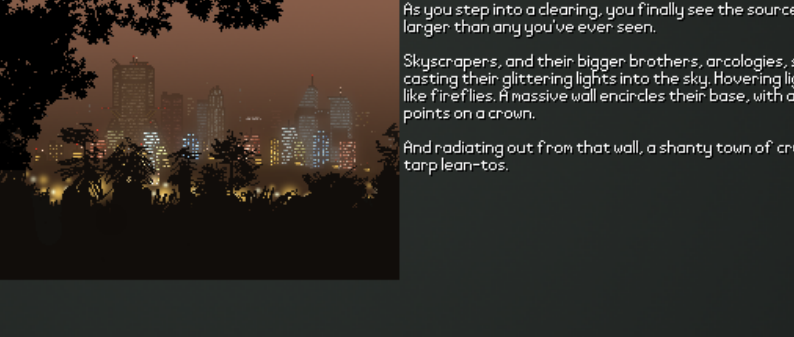
CLINIC SERVICES AND CYBERNETIC AUGMENTATIONS:
The clinic has been implemented in the game as a second wind of sorts for player characters which are about to die. For example, severe blood loss is likely to be fatal even if the player manages to staunch the bleeding in time and has enough food to last the player character for a long while. The clinic will be able to reverse this disaster – if the player character has the money to pay for the blood transfusion.
The clinic can also install cybernetic augmentations, but as of the latest build of the game, they were only for the player character’s eyes. One of the options removes the Myopia trait, replacing it with Eagle Eye or giving Eagle Eye if the player character does not already have it. Players who know this can plan for the character creation stage, e.g. giving the player character Myopia so that it can be removed later at the clinic and not taking Eagle Eye because the clinic will give it anyway.
It can seem odd that there are no other cybernetic augmentations, considering that the text descriptions of the clinic strongly suggest that it has the technology to offer these. Perhaps this limitation had been deliberately designed into the game so as to somehow preserve gameplay balance.
MONEY:
After reaching New Detroit, the player character can then accrue money. The main way to do so is to sell stuff over at the Junk Market, which appears to trade at a fair 1:1 rate.
Money goes into a counter that is separate from the inventory system. Presumably, the player character has an electronic account of sorts to explain this oddity, but the account can be used even before the player character has visited the New Detroit bank.
Anyway, money is what the player would need if he/she wants to obtain fresh items; curiously, any item that spawns for sale at the so-called Junk Market always start at 100% durability and stays that way, unless they are food items, in which case they will degrade over time (and become cheaper).
An observant player would eventually learn which items fetch the highest prices at the Junk Market. For example, bullets are easily the most expensive items, price-to-space ratios considered, so an experienced player would consider keeping these whenever and wherever they are found at the expense of any other kind of loot, if money is the player’s goal.
ITEM CONDITION/DURABILITY:
One key gameplay factor in NEO Scavenger is that almost anything that is useful will not last forever. This eventuality is expressed via the “condition” rating of an item, which is analogous to the gameplay element of “durability” and “item uses” which are found in other games where the player character is not expected to be able to continuously use something for long.
However, unlike many other games, there are no ways to restore the condition of an item in NEO Scavenger. On the other hand, the condition of an item does not appear to affect its performance. For example, a torch will always provide the same lighting regardless of its (rapidly deteriorating) condition.
This can serve to make every useful item seem particularly precious. For example, in the first few hours of a playthrough, a player will have to be very frugal with the use of any lighter which he/she found.
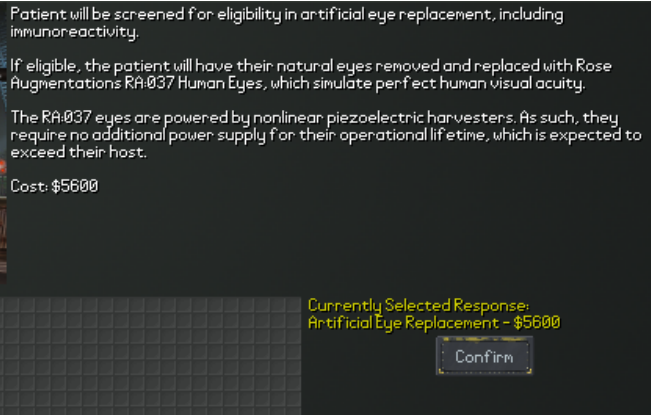
Of all items, food items, especially meat, degrade the fastest. This means that the player must consider disposing of them (either through trade or simply consuming them) as early as possible while being as efficient as possible.
Interestingly, there are items with no condition meters whatsoever, such as plastic containers (which is perhaps fitting). Oddly though, they often fetch low prices at the Junk Market.
SCARCITY OF GUNS AND AMMUNITION:
Although NEO Scavenger does feature firearms, its developer has made it clear that their presence will be far less than one would think.
Indeed, firearms and the bullets for them are next to impossible to come across while scavenging. Furthermore, without the “Ranged” skill, the player character will not be able to identify which bullets go into which gun. (The player could, through familiarity, know which bullets go into which gun through their appearance alone.)
More importantly, shooting is an act which is dependent on RNG rolls. The player character’s skill and other factors such as illumination do contribute to the threshold which the RNG rolls have to pass, but ultimately it is still a randomized number which determines whether a shot has landed or not.
COMBAT:
Although it is possible to have a playthrough where the player character avoids fights, the other characters are not disinclined towards fighting, especially if they are monsters or psychos. Therefore, the player will have to deal with what passes for combat in the game, sooner or later.
Moving into the same tile as another character, or having another character move into the same tile as the player character, will initiate the combat system. This happens regardless of the intent of the player or the other character. This is something that the game does not communicate clearly.
The player or a computer-controlled character can trigger the initiation of the combat system, but this does not necessarily mean that a fight has to happen. There are options which the player can take in order to have the player character attempt to communicate with the other character (if they are human). If either the player or the other character does not have the stomach for a fight, he/she/it can attempt to slip away.
Of course, if the player intends to start a fight and the other character is hostile, then a fight is likely to ensue.
Unlike the gameplay element of scavenging, combat relies more on skill and familiarity than it does luck. Although there are RNGs which determine whether an action would be successful or not, the outcome of a successful action is more in the control of the player than the outcome of a successful scavenging attempt.
For example, the player would eventually learn to make an attack when an enemy has the “Vulnerable” status; this attack is very likely to connect and inflict significant damage. As another example, the player could become familiar with the attack habits of a specific type of enemy, and choose to parry or dodge according to this knowledge when an attack attempt would seem riskier than a defensive action.
Unfortunately, the player is not shown the measurement of the chance of success for any action which can be taken.
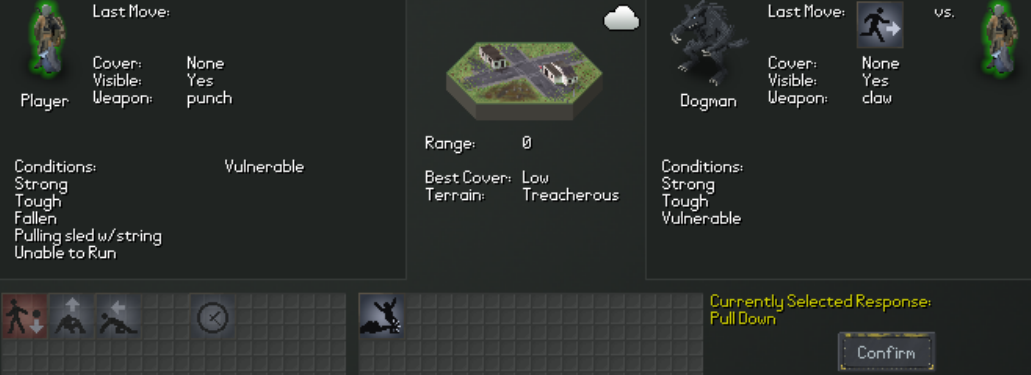
Combat in this game seems to be more complex than its user interface would suggest. The player has more than a handful of choices for just about any opponent, such as attempts to communicate with the enemy if it happens to be another human being. Even if the opponent is a beast, the player could still choose actions that attempt to intimidate the beast, such as yelling at it in an attempt to scare it off.
(Of course, the player character will need to be at an advantage in order to succeed in an intimidation attempt.)
As for combat moves that actually inflict injuries, the diversity of these depends on the player character’s surroundings and his skills. The skills with apparent uses in combat generally provide more options. For example, the “Strong” skill will allow the player character to dump obstacles on the opponent, hurting them and pinning them down.
Speaking of skills, the player might find that player characters without at least one combat-oriented or evasion-oriented skill would be at a disadvantage almost from the onset of a fight that is not already much in the favour of the player character.
There are no health meters which the player can use to keep track of. Instead, the player is shown labels, such as “severely wounded” if one (or more) of the combatants are close to death’s door, or “unconscious” if one of them has been knocked out.
PURSUIT & EVASION:
As mentioned earlier, the player character, or the other character, can attempt to disengage from combat if he/she/it is not feeling up to that. There are options which the character can take in order to evade his/her/its enemy, whereas the enemy can choose to give pursuit. Unfortunately, there may be a problem with how the game handles the outcome of a pursuit.
The characters which are attempting to escape and those who are trying to pursue will actually move across the map while the chase occurs. However, the player is not shown where the characters are going to; the most which the player can see is the tile that they are on.
Furthermore, the characters are actually spending moves as the chase continues, meaning that other characters on the map also move too. This can result in them bumping into other characters, which can complicate things.
MULTIPLE OPPONENTS:
Combat does not just occur between two characters. The player character is almost always alone, but other characters, such as hostile psychos, can gang up on the player character – the outcome is almost always bad for the player. While the player character can only focus on one enemy, each enemy can make its own attack against the player character. This can become unmanageable very quickly, especially if the player character lacks any crowd-control option (i.e. options which temporarily disable enemies).
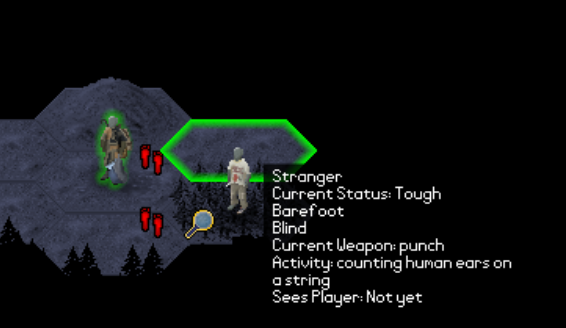
HIDING & SPYING:
NEO Scavenger has its own attempt at stealth-oriented gameplay elements. At any time in the default map screen, the player character can spend some move points to go into hiding. When in Hiding mode, any movement costs are doubled; in return, the player character becomes more difficult to be spotted by other characters. In the case of player characters with the “Sneak” skill, this is particularly so.
Characters who are pursuing a sneaking player character will eventually lose track of the latter, if the latter can build distance between him and them. There is another way for other characters to catch up with the player character though, as will be described later.
The act of “spying” can be done by the player character on other characters which he has spotted (and possibly vice versa). After the player character has spied on another character, the player will be shown information on what the latter is doing, his/her/its condition and whether the other character has spotted the player character in turn.
The player can then decide on what to do next with this information. For example, if the other character is badly injured, the player might want to consider having the player character finishing off the other character, if only to loot stuff off the other or in the case of the other character being an animal, cut it up for flesh.
(There is no apparent karma system, by the way, so the player could have the player character be as cruel as he/she likes him to be.)
Other characters appear to be able to examine the player character as well. Some of them can indeed be spooked by the player character, especially if he has combat-oriented skills.
TRACKING:
All characters leave behind tracks as they move across the map. In the case of the player character, the player will be able to see the player character’s tracks, as long as he can see the tiles which he had travelled over previously.
If the player character has the Tracking skill, the player will be able to see the tracks of other characters too. Furthermore, the tracks usually inform the player of the nature of the other characters.
Tracks will disappear over time, but until they do, characters with tracking abilities can follow these tracks, and may even be able to discern other information such as the condition of the characters who are being tracked.
The player can have the player character spend move points in order to (somehow) remove half of the tracks which he has made, starting from the trailing end. This might be able to deter would-be pursuers who have come across the trailing end earlier, but it will likely not be enough to shake off those which already have spotted the player character and are intent on running him down.
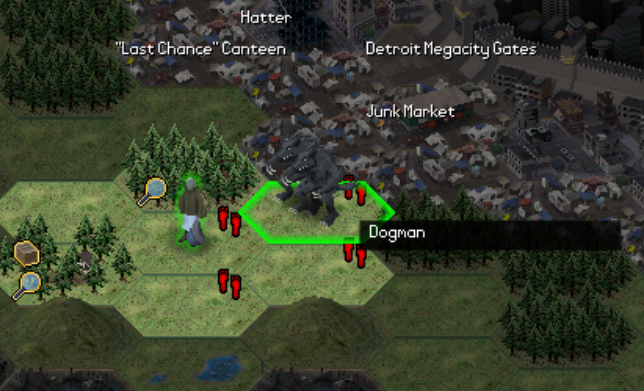
CARTONS & BAGS:
Container items have been mentioned earlier, but there are more remarks to be made about them, specifically cartons and bags.
Some items can be expanded into bags, such as plastic bags and potato chip bags; they allow items to be stored inside them. When the bags are empty, they are automatically scrunched into more compact forms, which means that the player can carry spare bags around.
Cartons, on the other hand, cannot change into a more compact form if they are empty. However, to compensate, cartons usually have better durability than bags do.
Cartons and bags can either be stuffed into containers which are worn on the player character’s person, or held in his hands; more often than not, the latter is usually the case because the player will want to free up space in more useful containers.
The main problem with cartons and bags is that if they have been placed into another container, the player cannot interact with the items in them without choosing to empty the cartons and bags out. (This will fill the container which they are in with the stuff that was previously in them, further complicating inventory management.)
To be able to handle the items in the cartons and bags, the player character has to hold the cartons and bags in his hands. This can be tedious. (For whatever reason, it does not matter if he is actually holding things in both of his hands; the player does not need one of his hands to be free.)
RUNNING:
If the player wants to have the player character getting somewhere as soon as possible, or wants to have him escape from a pursuing enemy, the player can set him to “Run”. This allows him to move further in his turn than when he is not running, but this will cause him to tire out a lot faster.
However, this feature is not likely to be used much by a meticulous player, due to the deliberate limitations of another gameplay element that will be described shortly.
‘VEHICLES’:
Although there is an inventory slot for “vehicles”, “vehicles” in this game are little more than sleds or carts which the player character pulls or pushes around, whichever applicable.
After the “vehicle” slot has been filled, the option to run is disabled. However, the player character can abandon the cart or sled during combat in order to start running. The abandoned “vehicle” can be recovered later if the coast is clear and the player character can return to where it was, but it would likely have been ransacked, especially if whoever drove him away is another human.
“Vehicle” items cannot be placed into another container. This means that vehicle items will eventually be destroyed due to wear and tear.
There may be a bug concerning the storage of bottles with liquids in some vehicles. In the case of vehicles such as the shopping cart, placing such bottles in them causes their contents to be emptied for no explicable reason. This is incredibly annoying to learn the hard way, especially if the liquid which was lost is of particularly high value (such as whiskey).
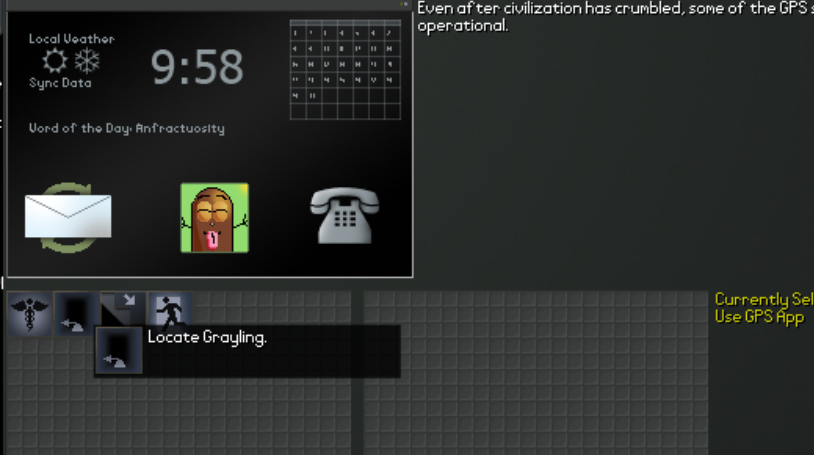
PROTECTION FOR ITEMS IN CONTAINERS:
Items which are stored in containers will not degrade as fast as those which are stored elsewhere. In the case of non-perishable items, they will hardly deteriorate at all if they are stowed away in containers. As for perishable ones, such as meats, they will still deteriorate, but at a much slower rate.
However, the container which they are in will deteriorate. When its condition reaches 0%, the container will disappear, and its contents will be emptied into the grid for items on the ground. All the warning which the player would get about this are a text pop-up above the player character’s sprite and a message in the message log, so the player will want to keep an eye on the durability of the container.
ELECTRONIC DEVICES:
The player will come across electronic devices such as smart-phones, tablets and rarest of all, laptops. They might seem worthless in the wilderness of semi-post-apocalyptic Michigan, but they do have some uses, if the player could locate the software packages which are compatible with them. The player may have to jump through many hoops before they can be used though.
Most electronic devices which the player would come across are already out of charges, and charging them is generally not possible until after the player has reached New Detroit and gained access to the illegal power taps in its shanties. The devices might even be missing their batteries. Furthermore, each type of electronic device uses its own type of battery.
On the other hand, charges can be easily transferred from one battery to another, even if they are of different types; the charges can be handled like they are individual items, and as long as they are kept within a battery, they are portable. Therefore, after the player character has reached New Detroit, he can carry spare batteries of any kind with charges in them in anticipation of the discovery of any electronic device later.
When it is found, an electronic device might be locked; as long as it is locked, it is useless. Cracking software will be needed to unlock a device, and this software needs to be loaded on an already usable electronic device. Furthermore, the cracking software has to be matched to the same type as the device to be unlocked, and cracking software can only be loaded on laptops. Player characters with the “Hacking” skill can bypass some of these requirements, however.
After an electronic device has been obtained and unlocked, it has to be loaded with software in order to be useful. For this purpose, the electronic device acts like a container, but it can only contain batteries and software which match its type. In the case of software, their icons are conveniently colour-coded according to the electronic devices which they are compatible with.
As for the software, there are software packages which turn a device into a light source, which contribute to certain story-specific situations, and which are used to crack electronic devices of specific types.
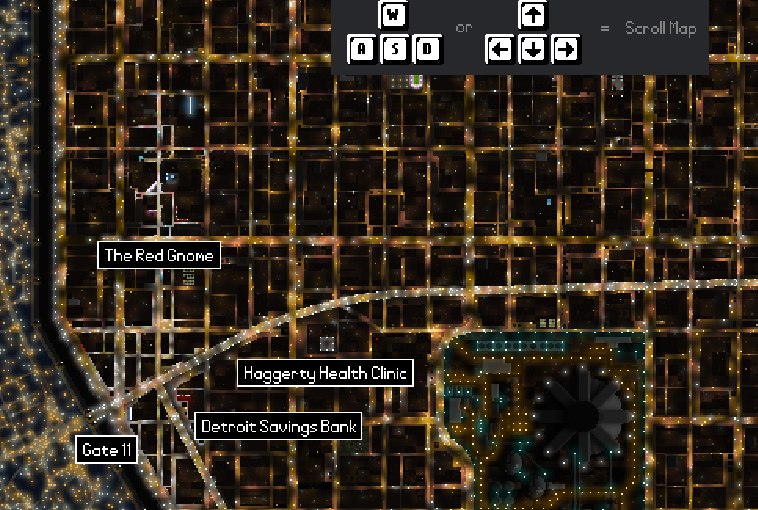
Software packages can only be stored in electronic devices, or Flash drives. Speaking of Flash drives, they can also be used to store other digital stuff, such as messages. Some messages (such as bank account information) and software packages (especially cracking software) fetch a considerable price at the Junk Market. Furthermore, software cannot decay.
Therefore, after the player has reached New Detroit, keeping an eye out for electronic devices to crack and having spare empty Flash drives may be worth the trouble.
Unfortunately, the handling of electronic devices are just as finicky as the handling of cartons and bags. The player character must be holding electronic devices and flash drives in his hands in order to be able to transfer software packages around.
DAY/NIGHT TRANSITIONS:
As the player spends turns, the time of the day progresses. Eventually, day will turn to night, and night to day. The change is usually observable through the changes in the sight range of the player character. However, these changes will be more abrupt if the weather changes as well.
The onset of night is particularly noteworthy, though this is not in praise of the game. Once the time of the day has gone into the nightly hours, the sight range of the player character plunges – he will not be able to see further than the tile that he is on, unless he has access to night vision.
At night, his movement points are reduced to just 1.00, if he does not have a light source (which will not extend his sight range) or night vision. This can be a problem, because movement points are also used for another major gameplay element: crafting.
CRAFTING:
Crafting is a gameplay mechanism which complements scavenging. The player character is a surprisingly resourceful person, though unlike so many other survival games, NEO Scavenger does provide explanations for this, or at least implications about this.
All the player needs to do for crafting is to have the ‘ingredients’ for a crafting ‘recipe’, and the move points to do so. The recipes are not very clear about how many move points would be needed, unfortunately; the player will need to depend on his/her experience to keep this in mind.
Some of these recipes are not really crafting recipes, however. Some are practically actions that could have been better off designed with a gameplay mechanism of their own. For example, there is a ‘recipe’ for using water analysers with untested water to ‘craft’ either sterilized water or infected water (which one the player would get is an RNG-dependent outcome). This could have been implemented as a “use” function for the water analysers.
Many crafting recipes require certain skills as “ingredients”. For example, cured meat requires the “Survival” skill. This is where the player’s choice of skills will be rewarded; many of the recipes which are unique to specific skills happen to produce rather useful things.
Unfortunately, this also highlights a major problem with the crafting mechanism: its user interface is a mess. The left-hand-side grid lumps all ingredients together, whether they are actual items, skills or even something that is specific to the weather (such as sunlight during sunny days). There are no filters, and it can be tedious to look for ingredients which happen to be very small items.
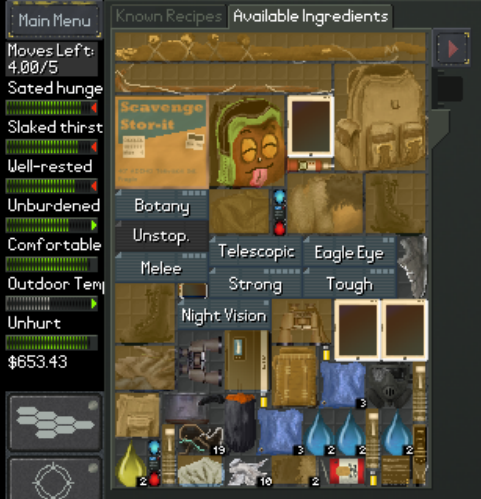
ENEMIES (& NOT-FRIENDS):
There are many characters who would be quite hostile to the player character. Some of them are desperate humans, too hungry or thirsty to ask for help. Some others are animals, such as feral dogs, which are also too hungry to be nice. Then there are outright monsters, such as the dogmen, and more hideous things like the Enfield Horrors and the ominously-named Yezinka (apparently named after characters in a certain Bohemian fairy tale).
Many of the non-human enemies have capabilities that can be difficult to counter, such as leaps and pounces. However, they can still be injured and slain, if the player character can dodge or survive their attacks. Non-human enemies also will not use guns.
Human enemies are generally easier to kill than clearly monstrous ones, as in they take less hits before dying, but they happen to be armed most of the time, usually with improvised weapons. Yet, this also means that human characters are often carrying gear on their persons, so there is always a chance of getting some useful loot from them. However, amusingly, they may be carrying items which the player has left behind earlier.
Then there are characters who are not immediately hostile to the player character. Most of these are humans. Even the ones whom the player has spied on and have been determined to be dangerously crazy might want to talk to the player character instead of attacking him.
If the player character can successfully start a conversation, they may make canned remarks such as telling the player character to watch his back because there are monsters which walk on two legs. Some characters may have more substantial dialogue options, such as asking for a trade.
As mentioned earlier, other characters can suffer most of the same problems as the player character can, such as injuries and poisoning. This means that the player might come across characters in bad shape. More often than not, the most that the player character can do is to kill them in their weakened state. However, there are a few rare instances where the game may trigger a special scenario in which the player character may be able to render aid. On the other hand, as had been mentioned earlier, there is not much of a karma system, so the player should not expect that good deeds would be rewarded.
VISUAL DESIGNS:
It should be immediately apparent that NEO Scavenger is not a game that is gunning for stellar artwork or presentation. Everything looks deliberately pixelated, as if hand-drawn pictures have been strained through a filter to make them look so. There are hardly any animations either; most of what the player would see are the appearance and disappearance of completely unanimated sprites. If there are any animations to be had, some can be seen in the falling of raindrops during rainy weather.
All these limited visuals would have been acceptable if they actually have significant gameplay-aiding function. Unfortunately, there is not a lot to be had here either.
The different designs for the icons of different items do help the player differentiate one thing from another in the inventory management screens. Yet, items of just one cell in size can be difficult to differentiate from each other. For example, the icon for shotgun shells is just a couple of colours away from the icon for a certain type of candy.
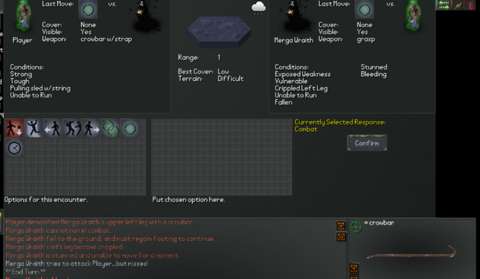
If there are any visual designs with worthwhile significance to gameplay, it is the system of sprite visuals for human characters. Every human character is by default depicted with a grey humanoid. If the character is carrying, wearing or otherwise equipping anything on his/her person, it will be shown on his/her sprite. This allows the player to estimate how difficult a human opponent would be.
SOUND DESIGNS:
The only sounds to be heard in this game is its very few, demure musical tracks, the sounds of rain, and crickets during night-time. There are sounds which are associated with the items that the player would handle, but these do not contribute much to the gameplay element of inventory management.
SUMMARY:
NEO Scavenger could have been able to provide a convincingly refreshing shake-up of the formula that is used for the gameplay of survival-oriented games. Its boardgame-like system of exploration makes for a manageable pace. The inevitable deterioration of gear and the myriad of debilitating conditions introduce a sense of urgency that the game’s turn-based gameplay does not.
Unfortunately, the game is afflicted with tedious inventory management and finicky user interfaces, the latter carrying with it just as much disappointment (over its wasted potential) as it does annoyance.
Most importantly, the enjoyment of the game is damaged by the preponderance on luck in its eponymous gameplay element. NEO Scavenger is one of those games which would punish the player for having bad luck sooner than it would reward the player for making wise decisions.

